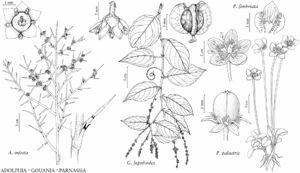Parnassia fimbriata
Ann. Bot. (König & Sims) 1: 391. 1804.
Herbs with caudices. Stems 10–35 cm. Leaves: basal in rosettes; petiole 2–16 cm; blade (of larger leaves) orbicular-reniform to reniform, 10–50 × 15–60 mm, base cordate, apex rounded; cauline usually on middle to distal 1/2 of stem. Flowers: sepals reflexed in fruit, oblongelliptic to ovate, 4–6 mm, margins hyaline, 0.2–0.5 mm wide, denticulate, erose, or short-fimbriate distally, apex rounded; petals 5–7-veined, oblanceolate to obovate, 8–14 × 4–8 mm, length 2 times sepals, base cuneate, margins fimbriate proximally; stamens 6–9 mm; anthers 1.5–2.5 mm; staminodes oblong-obovate, irregularly divided into 5–10+ oblong, obtuse lobes, usually glandular at apex but tip not differentiated into distinct gland, 3–5 mm, shorter than stamens; ovary green. Capsules 8–12 mm. 2n = 36.
Phenology: Flowering summer.
Habitat: Stream banks, wet meadows, fens, seeps in forest glades, alpine ravines.
Elevation: 10–3200 m.
Distribution

Alta., B.C., N.W.T., Yukon, Alaska, Calif., Colo., Idaho, Mont., Nev., N.Mex., Oreg., Utah, Wash., Wyo.
Discussion
Selected References
None.
